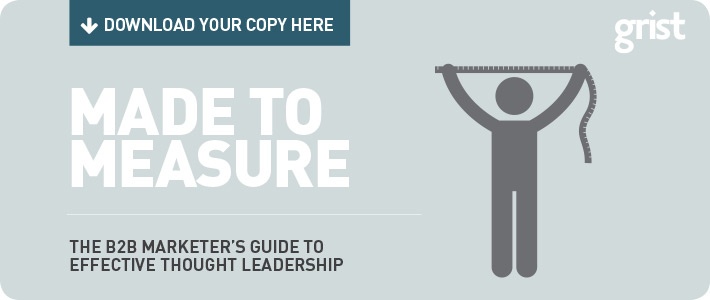We’ve made the business case for B2B thought leadership surveys, and looked at the survey options available. Now let’s take a look at how you get the all-important results.
In our experience, the success of a B2B survey depends on seven critical success factors:
- Objectives
- Audience
- Story
- Questions
- Sample
- Method
- Outputs
1. The right objectives
Beware the most common trap: no successful B2B survey sets out just to ask some ‘interesting’ questions. That will waste time and money producing data that has little use.
The first step in an effective research-based campaign is to think through what you want the survey to achieve. Factors to consider at the outset include:
- What are your overall marketing objectives?
- How does your campaign align with them?
- Is it an external or internal campaign?
- Is the survey intended for content marketing purposes, or to gather market intelligence?
- What sort of outreach should it enable (eg, sales, PR, marketing, internal comms)?
- Do you need ‘listen and find out’ research, or to prove a hypothesis that will help promote your offering?
2. The right audience
Define your audience carefully. Your survey must reach out to people who can provide genuine insight into the topic at hand.
Getting to the right audience means thinking carefully about the job roles, sectors and sub-sectors to target. For example, ‘financial services’ covers everything from banking to insurance and asset management. Do you really wish to target them all?
Once you’ve defined your audience, it’s essential to pre-screen respondents. Don’t be tempted to skip this stage, as job titles can be very misleading.
A final thought on audience targeting: think twice about using panels in the B2B domain. Panels have a tendency towards inherent bias. Respondents are often shoehorned in from consumer panels, and some may be ‘serial respondents’. This won’t give you a true reflection of the market.
3. The right story
So how do you make sure your survey generates the messages that your campaign requires? And how do you design it to generate powerful and provocative findings?
The answer is to start with the end in mind, and work backwards from there. Think about the story you want to tell, and/or hypothesis you want to prove. What headlines do you want to see in the media? And what sales conversations do you want to have with clients and prospects?
You can then design your survey to achieve the desired endgame, assuming of course the market supports the hypotheses! You can mitigate the risk of not getting to your end-goal by reviewing interim data as well.
4. The right questions
It sounds obvious, but to get the right answers, you need to ask the right questions.
If busy senior executives are to give up their time for your survey, then your questions need to get them thinking about interesting issues. The questionnaire must engage your target respondents by sparking a conversation they’ll enjoy.
But it’s not just what you ask; it’s also how you ask. Think carefully about how to frame your questions and response mechanisms.
Here are a few pointers:
- Encourage respondents to make definite choices. Avoid middle-of-the-road response options, and ‘don’t knows’ where possible.
- Too many ‘rating’ questions puts respondents off. The survey becomes a frustrating experience if they’re asked to repeatedly score elements from one to five.
- Make sure the survey isn’t too long. Otherwise, you’ll encounter high drop-off rates – especially among time-poor senior audiences, and the quality of data suffers.
- Always translate international surveys. Not everyone speaks English. And even if they do, the nuances in your questions, and in their answers, may get lost.
- Be bold. Stark attitude statements produce more powerful findings than moderate ones – even if only a minority of respondents agree. ‘20% of firms have no CEO succession plan’ beats ‘65% are concerned about CEO succession’.
5. The right sample
Make sure you know how many people you need to reach: different target audiences require sample sizes to be representative of the group as a whole. At the same time, be realistic about what can be achieved. Set feasible numbers for your market. Speaking to every FTSE100 CEO almost certainly isn’t going to happen.
If you do your homework properly, you can take the guess-work out of research and be sure of getting the right number of respondents. As a rule of thumb, B2B surveys need a 1-in-10 ratio. This can be ratcheted down if the total ‘universe’ of respondents is particularly small. But in general, a 10% sample size ensures robust findings, reduces the potential for bias, and passes the credibility test with journalists. Also for each area that you want to look at in isolation, you need to ensure the sample size is sufficiently robust.
6. The right method
How to contact respondents is another crucial consideration.
Different data collection exercises suit different audiences. An online approach may work better for more junior respondents, but telephone outreach will be necessary for the C-suite. If you need to probe deeply, then telephone is best. If you have a lot of rating and ranking questions, online works perfectly. There is no one-size-fits-all approach: the method needs to take account of the target audience, the question structures, speed of data collection needed and length of interview.
7. The right outputs
There’s a wealth of content marketing assets you can generate from the results of a survey. Design it right, and you can use your data time and again.
Potential outputs range from full-blown, interactive thought leadership reports, all the way down to 140-character tweets announcing the headline findings. We’ll look at these in more detail in our next blog.
Which to use will depend on a range of factors, including the tools and resources available to you, your marketing team’s capabilities, budgets for external support, and as noted, your marketing objectives.
More to come…
At Grist, we’ve helped many B2B brands to realise the power of surveys as a content marketing tool – and also as a source of competitive intelligence. This blog has shown you how to ensure B2B surveys are successful; previous blogs looked at why B2B surveys are so effective and what survey formats you should explore; upcoming blogs will run through the plethora of assets you can create to engage clients and prospects at all stages of the BD pipeline.
In the meantime, please get in touch if you’d like to discuss how a survey could help make your campaigns more effective.



